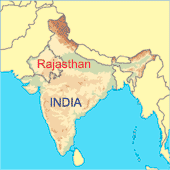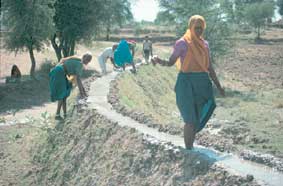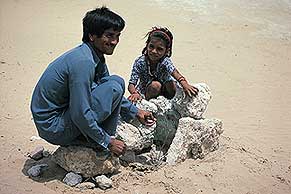|
Water
Shortages
Drought
is a part of life for the people on the edge of the Thar desert
in Rajasthan, India's poorest state. As a result of unreliable rainfall
in seven of the last ten years, the region has suffered from a triple
famine; not enough water, not enough food, not enough animal fodder.
Acute shortages of food and water have also led to worsening health
problems, a lack of hydro-electricity, and many younger people have
chosen to move to cities like Jaipur in search of a better life.
�
The
Friends of Rajasthan
To
lend support to the people of Rajasthan, the "Friends of Rajasthan"
projectwas set up by a group of UK secondary school teachers. The
project has enabled students to live and learn with 25 village communities
in the area of Khandel, Rajasthan, working in partnership with a
local non-government organisation called Nirman Sanstha Khandel.
Since 1990, thirty groups of UK students have visited the area to
involve themselves in projects to capture and save the limited water
supply known as 'water harvesting'.
Click
here to find out what one of the founders of the "Friends
of Rajasthan" says about the project.
|
|
"Despite
their terrible fight to harvest the water, the villagers were
so optimistic and welcoming. Their animals were dying, their
yields were down and the water levels in the wells lower and
lower each year, but still they smiled. It made me think of
how we whinge and moan when we have a 'drought' in the UK
and we can't water our flowers or wash the car... that's not
a drought!"
Tom
Bradley, a participating student, remembers visiting Dhoon
village.
|
 |
|
�Julian
Cottenden
|
|
Water
is drawn into the top of the bund by a buffalo to create an
irrigation channel. Gravity does the rest.
|
|
Water
Harvesting means a lot of Hard Work!
Water
harvesting can take many forms, and students have worked
alongside local villagers on many projects to improve water
management. To store water, village ponds need to be deepened
and cleared of weeds and silt and wells need to be repaired
and cleaned. Earth walls called 'bunds' also need to be constructed.
Bunds are used across the developing world as a cheap, simple
and sustainable way of managing limited water resources. They
prevent rainwater and soil from being washed away, and the
top of bunds can be used as irrigation channels.
|
�
Click
here to find out what Brian Jones, one of the participating
students, thought about taking part in one of the water management
projects.
|
�
|
The
Multipurpose Tree
 |
Near
their village, a father and his daughter use rocks to
shade a tree sapling from the baking sun in the hope that
it will grow |
|
�Julian
Cottenden
|
Planting trees not only helps in saving water... trees
bring other benefits as well:
- Tree
roots help to bind the soil, slowing water run-off and reducing
soil erosion.
- Leaves
and branches change the microclimate
and allow shade-loving crops to thrive beneath them.
- Trees
provide fodder for animals and building materials for villagers.
- Neam
trees planted by Rajasthan villagers have about fifty different
medicinal uses
|
�
Learning
to do Things Differently
Since
the "Friends of Rajasthan" project started, 'experts' from outside
have learned to take a backseat in decision-making to ensure a more
sustainable approach to water management. Today, it is the villagers
themselves who make the decisions. Villagers are encouraged to meet
and discuss their problems together to come up with collective solutions
to water shortages. Before adding a pump to reach water deep underground,
the villagers decide how to split the cost, and they nominate a
local person to receive training in installing and maintaining the
pump. This way, the local community are assured a self-sufficient
way of getting water that will last well into the future.
�
|

